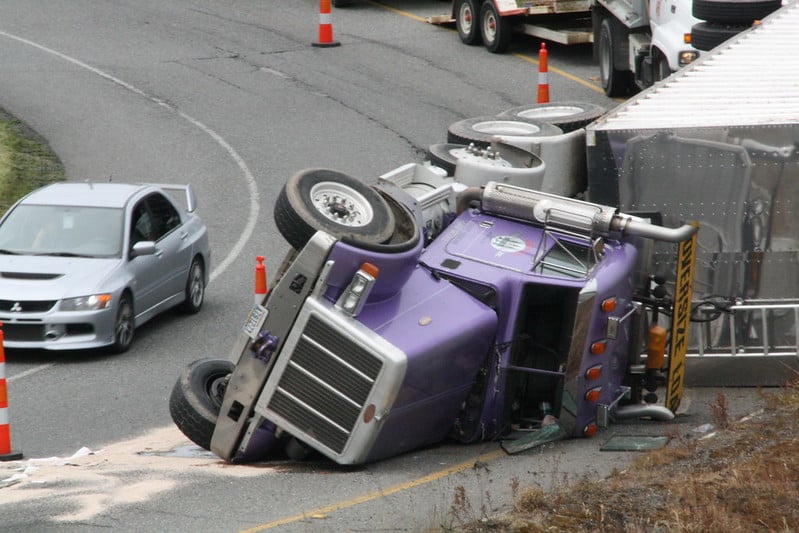A jackknife truck refers to a type of accident involving an articulated vehicle, such as a semi-truck or tractor-trailer, where the trailer swings out and forms an acute angle with the cab, resembling the shape of a folding pocket knife.
These accidents can cause severe disruptions on the road, leading to traffic congestion, injuries, and significant economic losses.

Fatal Truck Accident Stats
| Statistic | Number | Percentage |
|---|---|---|
| Total deaths in large truck crashes | 4,764 | 100% |
| Passenger vehicle occupants | 3,124 | 66% |
| Truck occupants | 823 | 17% |
| Pedestrians, bicyclists, and motorcyclists | 755 | 16% |
| Increase in fatalities since 2009 | 1,616 | 51% |
| Large truck occupant fatalities increase since 2009 | 374 | 83% |
| Fatalities on major roads | 2,318 | 49% |
| Fatalities on interstates and freeways | 1,688 | 35% |
| Fatalities on minor roads | 741 | 16% |
| Large truck occupant deaths in multiple-vehicle crashes involving another large truck | 219 | 61% |
| Passenger vehicle occupants killed in two-vehicle crashes with large trucks | 2,418 | 96% |
| Fatally injured large truck drivers with BACs ≥ 0.08% | 29 | 4% |
Understanding Jackknife Trucks
Understanding the dynamics of jackknife trucks is essential for both drivers and those sharing the road with these large vehicles.
By gaining a comprehensive understanding of jackknife trucks, stakeholders can work together to create safer road environments.
Definition of a Jackknife Truck
A jackknife truck accident happens when a truck’s trailer skids and swings out to the side, forming a sharp angle with the truck’s cab.
This usually looks like a folding pocket knife—hence the name. It often occurs when the wheels of the trailer lose traction on the road surface.
Importance of Understanding Jackknife Accidents
Understanding jackknife accidents is vital for everyone on the road, not just truck drivers. These incidents can block multiple lanes of traffic, cause extensive property damage, and result in serious injuries or fatalities.
By learning about the causes and effects of jackknifing, drivers can take steps to prevent these accidents, making roads safer for all users.
Overview of the Structure of Articulated Vehicles
Articulated vehicles, such as semi-trucks, consist of two main parts: the cab (or tractor) and the trailer.
The trailer is connected to the cab by a pivot point, allowing for greater maneuverability. However, this design can also lead to jackknifing if the trailer swings out of control.
The connection point’s flexibility is both a strength and a vulnerability, especially in adverse driving conditions.
Common Scenarios Leading to Jackknife Incidents
Jackknife incidents can occur in a variety of situations, often when the driver loses control of the trailer. Recognizing these common scenarios can help drivers avoid actions that may lead to a jackknife accident.
- Sudden braking, especially on slippery or uneven roads, can cause the trailer to swing out.
- Sharp turns at high speeds or abrupt maneuvers to avoid obstacles can lead to loss of control.
- Wet or icy road conditions reduce traction, making it easier for the trailer to skid.
- Driving too fast for the conditions, such as during heavy rain or on winding roads.
- Improperly loaded trailers that shift weight unexpectedly during transit.
Understanding these scenarios and how they contribute to jackknifing is crucial for improving road safety and preventing accidents.
Impact on Traffic and Road Safety
When a truck jackknifes, it can block multiple lanes of traffic, causing massive delays and increasing the risk of secondary accidents. The blockage often requires extensive cleanup and towing efforts, which can disrupt traffic flow for hours.
Moreover, jackknifing poses a significant danger to other motorists, who may not have enough time to react and avoid collisions.
Legal Implications and Responsibilities
Legal responsibilities in jackknife accidents can be complex.
Determining fault often involves assessing the driver’s actions, vehicle maintenance records, and road conditions at the time of the incident. Trucking companies may be held liable for inadequate training or maintenance.
Victims of jackknife accidents may seek compensation for injuries and damages, leading to lengthy legal battles.
The Physics Behind Jackknifing
The physics of jackknifing involves the loss of traction and momentum.
When a trailer loses grip on the road, it begins to swing out due to inertia. The cab may continue moving forward, creating a folding action. This loss of control is often exacerbated by high speeds and sudden maneuvers.
Understanding these principles can help drivers maintain control in critical situations.
Importance of Preventive Measures
Preventive measures are crucial in reducing the risk of jackknife accidents. These include regular vehicle maintenance, proper driver training, and the use of advanced safety technologies.
Anti-lock braking systems (ABS) and electronic stability control (ESC) can help maintain traction and prevent skidding.
By prioritizing prevention, we can significantly reduce the incidence of these dangerous accidents.
Causes of Jackknife Truck Accidents
Understanding the causes of jackknife truck accidents is crucial for preventing them. Various factors can contribute to these dangerous incidents, ranging from driver-related issues to environmental conditions.
By examining these causes, we can develop strategies to reduce the risk of jackknifing on the roads.
Driver-Related Factors
Driver-related factors play a significant role in jackknife truck accidents.
Inexperience or lack of proper training can leave drivers unprepared for handling large vehicles.
Fatigue and long driving hours impair judgment and reaction times, leading to poor decision-making.
Distracted driving, speeding, and aggressive driving behaviors reduce the time available to respond to road conditions. Drivers need to remain focused and adhere to safe driving practices to minimize the risk of jackknifing.
Vehicle-Related Factors
Vehicle-related factors also significantly contribute to jackknife accidents.
Mechanical failures, such as brake system malfunctions and tire blowouts, reduce traction and control.
Issues with the coupling mechanism or imbalanced trailer load distribution can cause instability.
Poorly maintained suspension and steering systems, along with malfunctioning anti-lock braking systems (ABS), further increase the risk.
Regular maintenance and timely repairs are essential to ensure vehicle safety and reduce the risk of jackknifing.
Environmental Factors
Environmental factors can create conditions that lead to jackknife accidents.
Wet or icy roads reduce tire traction, making it easier for the trailer to swing out. Poor visibility due to fog or heavy rain complicates the driver’s ability to see and respond to hazards.
Road design, high wind speeds, and road surface quality, including potholes, affect vehicle stability.
Awareness and adaptation to these environmental factors are crucial for preventing jackknife accidents.
Consequences of Jackknife Truck Accidents
Jackknife truck accidents can have severe and far-reaching consequences. These impacts can be categorized into human and economic effects, both of which can be devastating.
Understanding these consequences helps highlight the importance of preventive measures and quick responses to such incidents.
Human Impact
The human impact of jackknife truck accidents is profound. Injuries and fatalities are common outcomes, with victims often suffering from severe trauma.
Psychological effects, such as PTSD, affect both survivors and witnesses. Long-term disabilities can result from these accidents, altering lives permanently.
Families of victims face emotional and financial stress, needing extensive support to cope with the aftermath.
Economic Impact
Jackknife truck accidents also bring significant economic consequences.
Damage to goods and cargo disrupts supply chains, leading to financial losses. Repair and replacement costs for vehicles involved in the accident add up quickly.
Legal and administrative expenses can be substantial as victims seek compensation. Increased insurance premiums affect trucking companies’ bottom lines.
Additionally, traffic congestion caused by these accidents results in productivity losses and delays.
Preventive Measures and Safety Tips
Preventing jackknife truck accidents requires a multi-faceted approach. Both drivers and companies must take proactive steps to reduce risks, while regulatory bodies play a crucial role in enforcing safety standards.
By focusing on these areas, the frequency of jackknife accidents can be significantly decreased.
For Drivers
Preventing jackknife truck accidents starts with the driver. By following best practices and staying vigilant, drivers can significantly reduce the risk of these dangerous incidents.
- Comprehensive training programs ensure drivers know how to handle their vehicles in various conditions.
- Regular rest breaks combat fatigue, a common cause of accidents.
- Proper vehicle inspections before trips can identify potential issues that might lead to jackknifing.
- Adherence to speed limits and road signs is essential for safe driving.
- Maintaining safe following distances allows drivers more time to react to sudden changes in road conditions.
By adhering to these guidelines, drivers can play a crucial role in preventing jackknife accidents and ensuring safer roads for everyone.
For Companies
Trucking companies must invest in safety to protect their drivers and the public.
Regular maintenance and vehicle inspections are crucial for identifying and fixing potential problems.
Investing in modern safety technologies, such as anti-lock braking systems (ABS), can prevent accidents.
Implementing strict safety protocols and continuous driver education programs helps maintain high safety standards.
Monitoring driver behavior and encouraging a safety-first culture ensures that safety is always a priority.
For Regulatory Bodies
Regulatory bodies play a vital role in ensuring road safety.
Enforcing strict safety regulations helps maintain a high standard of vehicle and driver safety.
Regular inspections and audits of trucking companies ensure compliance with safety standards.
Providing resources for driver training programs helps improve driver skills and knowledge.
Promoting the use of advanced safety technologies can reduce the risk of accidents.
Developing and maintaining safe road infrastructures, such as clear road markings and proper signage, is essential for preventing jackknife accidents.
Contact a Houston Truck Accident Lawyer
If you or a loved one has been involved in a jackknife truck accident, it’s essential to seek professional legal help.
Contact Sutliff & Stout, your Houston truck accident lawyer, at (713) 405-1263 to discuss your case and ensure your rights are protected.
Their experienced team is ready to help you navigate the complexities of your claim and get the compensation you deserve.
- What is a Catastrophic Injury? - January 30, 2025
- Essential Guide for Pedestrians Hit by Cars in Texas - January 30, 2025
- How to File a Wrongful Death Lawsuit in Texas - January 15, 2025








 (713) 405-1263
(713) 405-1263  550 Post Oak Blvd, Suite 530
550 Post Oak Blvd, Suite 530